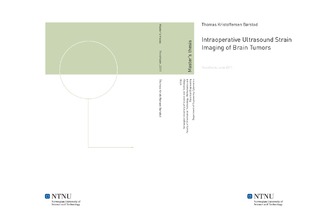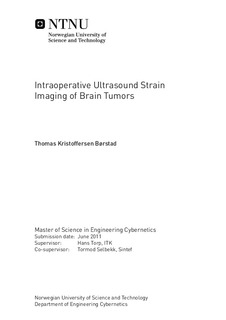| dc.description.abstract | Intraoperative ultrasound strain imaging of the brain visualizes brain tissue deformation as an image. The hypothesis is that strain and elastographic values can be used to complement conventional B-mode image in the task of brain tumor segmentation. A key asumption is that the natural pulsation of the cerebral arteries causes deformation in the brain tissue that is measurable with ultrasound.Strain values are found with a least-squares technique that estimates the spatial derivative of axial velocity, which in turn is mea- sured using a phase-based velocity estimator. A correlation coefficient is calculated for each estimate, giving an indicator of estimation accuracy. Additionally a method for hiding estimates of bad quality based on correlation coefficient thresholding is demonstrated. More- over, a novel elastographic processing technique suitable for cineloop display is introduced. This method extracts a stiffness parameter from a series of strain images, producing an elastogram. A graphical user interface allowing the user to change parameters and see the corresponding result in real-time, minimizing the time needed for parameter optimization, has been developed.The method has been tested using an elasticity phantom. The phantom elastogram cineloop shows a live image that visualizes the difference between stiff and soft tissue well, portraying information not found in the B-mode image. The conclusion is that the proposed elastographic technique, combined with correlation coefficient thresholding, produces elastograms that are suitable for real-time display. This technique is not limited to imaging of the brain, and could, with different parameters, be used for imaging other parts of the body as well.Clinical data sets from two brain tumor patients have been studied as well, where the estimated velocity, strain and elastographic values is discussed in detail. In both patients the tissue movement due to arterial pulsation was measurable with ultrasound. For one patient, a correlation was found between tissue pathology and estimated strain and elastographic values. For the second patient the strain and elastographic processing broke down, and no similar correlation was found. | nb_NO |

